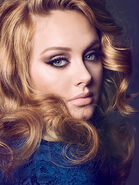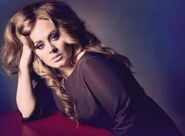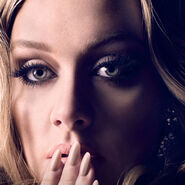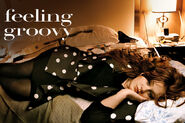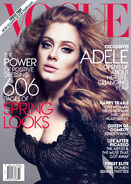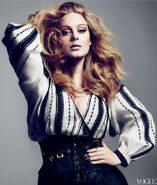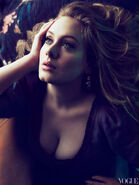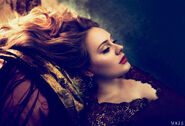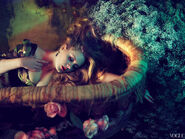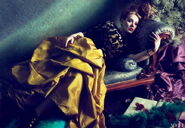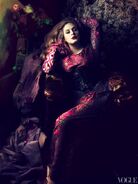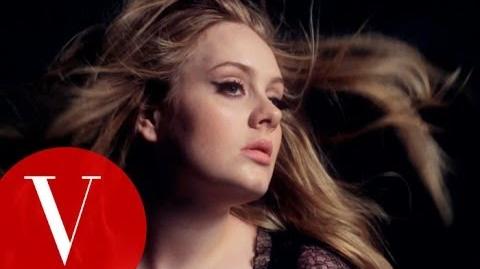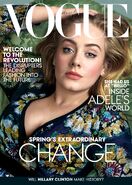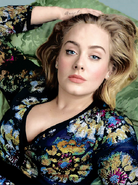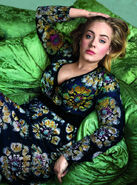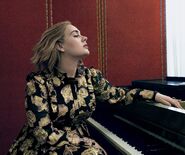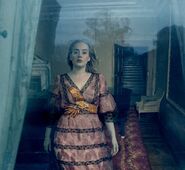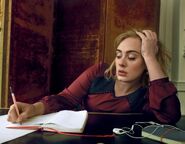Vogue magazine is a reputable fashion magazine headquartered in the United States. Adele has appeared on three covers of the magazine (once on the British version of the magazine and twice on the American version).
United Kingdom
2011
In October 2011, Adele covered the UK version of Vogue magazine.[1] She was interviewed by Christa D'Souza.
Shepherd's Bush Empire. Adele is playing for one night only and the music-hall-like venue could not be more packed. It's hot, there is standing room only and the screw-top wine is appalling, but even for those hell-bent on disliking live gigs the atmosphere is electric. Suddenly out of the darkness rings that soulful, bell-like voice with the opening bars of "Hometown Glory," the bestselling hit off her first album, 19, which she wrote when she was still a student. Thirty seconds later, to the frenzied hysteria of the crowd - friends such as Mark Ronson, James Corden, and Alan Carr scattered within it - the lights fling up. On she half totters, half runs, in a sparkly black brocade dress, her ginger-biscuit hair pinned back in Beyoncé-style ringlets. Theatrically she fans her creamy, ample bosom, then jumps up and down, clenching and unclenching doll-like fists to convey that for her, too, this is an awfully big moment. Eventually, unable to carry on over the din, she grabs a drumstick and raps a stand with it, like a conductor. All at once the shrieking mutates into an obedient singalong: "Round my hometown/ Memories are fresh/ Round my hometown/ Ooh, the people I've met…" Adele. Or Adele Laurie Blue Adkins, as it says on her passport. Doesn't matter if you are not particularly into the whole Brit "torch singer" thing. Doesn't even matter if you are not particularly into music. You will know of Adele. You will, even if only subliminally, have heard of "Someone Like You," the ballad she wrote about a botched love affair, which she performed at the Brits, making everyone (including herself) cry. Right now, there is no one who appeals quite this globally, who connects as much, from the 15-year-old boy who's had his heart broken for the first time to the fiftysomething who's on her fourth divorce. Or, for that matter, the nine-year-old who likes a catchy tune. Not only has 21, her second album, sold 3.5 million copies since being released at the start of this year, it broke the Number One record for a solo female artist, staying there for 11 consecutive weeks - two weeks longer than Madonna's Immaculate Collection in 1990. And then there's the lovefest between her, her childhood heroine Beyoncé and Jay-Z; Jay-Z who invited Adele to join Beyoncé on stage at Glastonbury (she couldn't, she had laryngitis) and Beyoncé who once compared the act of listening to Adele as "like listening to God." All this. And she is just 23. And a very sussed 23-year-old at that, as a mutual friend in the record business jokingly warns the week before I meet her. "Just go prepared," is all he will say. "She is… formidable." Two months have gone by since that Shepherd's Bush gig and she has been given the all-clear by her doctor from that nasty bout of laryngitis. We have arranged to meet at the Notting Hill headquarters of XL, the record label clever enough to represent her right from the start. XL founder Richard Russell, whose other discoveries include Basement Jaxx, the Prodigy and MIA, has kindly lent us his office, an airy loft-like space decorated with a stuffed elephant's foot, skull fairy lights, a computer screen balanced on a dictionary and three beaten-up leather sofas, upon one of which Adele is reclining. "Oi, oi," she says, looking up, "Adele… Nice to meet you, sit wherever you want…" and then erupts into the Catherine Tate-like "Nyahahahaha" cackle that has become such a part of her stage patter. Oh, good. She can talk. I'd been warned her voice was still very fragile. "Nah, it's not about not talking," she says briskly. "It's about talking only when you can actually touch the person. If I have to shout across the music to someone, that's when it's not good…" If anything is manufactured about Adele, it is her whole anti-manufactured shtick: the lack of pyrotechnics, of fancy marketing techniques, of saucy styling. Her distinctly non-Pussycat Doll physique, meanwhile, she makes absolutely no apology for. Quite the opposite. "I don't have a message," she says, inspecting her ghetto-fabulous (if slightly chipped) nails. "I enjoy being me; I always have done. I've seen people where it rules their lives, you know, who want to be thinner or have bigger boobs, and how it wears them down. And I don't want that in my life. It's just never been an issue - at least, I've never hung out with the sort of horrible people who make it an issue. I have insecurities, of course, but I don't hang out with anyone who points them out to me." Certainly she is terribly pretty in the flesh, with that luminous skin and those unflinching green eyes. Though sporting a few spots, she looks every inch the Brit diva, too, in her trademark false eyelashes and a black cocktail frock custom-made for her by Moschino, with its special Superman cape attached. "I do love a cape," she says, getting up and performing a little twirl. The only thing missing from this tableau is Louis, the beloved dachshund she named after Louis Armstrong - Louis, whose "balls I cut off because I didn't want to breed him - God, imagine if you could do that to humans, too, nyahahahaha…" The look, an updated version of Fifties prom, hasn't really wavered since Anna Wintour offered to style her for the Grammys last year and introduced her to the costume designer Barbara Tfank. It was Tfank who suggested she might look good in a cinch belt and, sartorially speaking, she has not looked back since. The days of the heavy fringe and the flowery Camden Market dresses and holey tights are gone. Even when she's in baggy jumpers and leggings, she'll wear a Louboutin heel and a nice bag. "I admire trends," she says. "Before I got into Johnny Cash and discovered June Carter and decided to wear nothing else but black from there on, I wore loads of colour, and like, miniskirts over jeans. But, like, now, I love old school. Chanel, Prada, you know. And Burberry, definitely. I've met Christopher [Bailey] a few times. He's definitely going to dress me for the next lot of awards - if I'm nominated. I've always loved Burberry. I remember saving for three years to get my first bag before I got signed. Five hundred quid, I think it was," she says, picking at a nail whose tip has fallen off, "made of canvas, with the logo, like a satchel." Those nails. As with Barbra Streisand, they are almost part of her act. I remind her of the time she once went on stage wearing a tampon with the stuffing scooped out over a finger, to protect a tip that was just about to fall off. "Yeah, but the tampon was the doctor's idea," she says firmly. "I didn't mean to go on with it, I just forgot to take it off." If you look out of the window, you can just make out the flat she rented between the ages of 19 and 22, before she moved back to south-west London to be nearer to her family. "I did a show from her house as part of the Live Lounge tour," says Radio 1's Jo Whiley. "It was a bijou flat in west London, the kind of area where pop stars live when the money comes in. But you could tell her heart wasn't in the place - for starters, it was too far away from her mum. When she showed me round, we found her Brit award in the loo - she said it seemed fitting." It was a lovely little flat, a stone's throw from two of her favourite places: E&O, where she used to eat "breakfast, lunch and dinner, until the paps caught on", and Ottolenghi "where they mug you up terrible with the prices. I know that from buying the cookbook and seeing how much the ingredients really cost! But I'll pay, 'cos I love it." She is thinking of moving back to the area, not least because she can do her supermarket shopping in peace - unlike at her local Tesco, where "the manager got on the Tannoy and announced there was a bloody superstar in the store." Not that that means she has to walk around in glasses and a wig, but she does have her little ruses. Like wearing a hoodie when she goes out for her daily walk in the park with Louis, or having her friends call out "Pam" instead of "Adele" when they've found a special deal on tomatoes or whatever - "as everybody knows, I always love a good deal." Nobody, in her wise opinion, however famous they are, needs to be hounded if they genuinely don't want to be: "Look at wikipedia:Meryl Streep, best actress in the world - nobody knows nothing about her, do they?" For someone who is so honest about her feelings on stage, Adele is a lot warier in one-to-one situations. Maybe that's because she has shared so much in the past; like the time she sounded off about having to pay too much tax (her estimated worth is in the region of £8 million) or called David Cameron a right "wally." Maybe it's because others have spilled about her, too, like her dad, a recovering alcoholic who left home when she was just three and sold his story to a tabloid in March. That, compounded with the time another tabloid ambushed her grandmother, Doreen, at her local bus stop in Tottenham, got her so upset she started smoking again (she's since stopped, because of the laryngitis). Perhaps, too, like many a professional, she turns on the "personality" only when necessary, saving up all those emotions for stage and then letting rip when she has an audience. Does she ever feel exposed up there, belting her heart out? She looks at me blankly at the idea of such a thing. "But that's the way I've always done it. I don't know any different. So it's really normal for me." "Right from the beginning, she's had a very clear idea of where she wants to be," offers Ben Beardsworth, XL's MD, an integral part of Team Adele (which also includes Richard Russell, her wily manager Jonathan Dickins, her agent Lucy Dickins and her producer Paul Epworth). "And it's all genuine. She hasn't learnt it or been taught it on the way. That's how she's always been, right from the start. It's quite spooky to have that degree of single-mindedness and clarity of vision and confidence and drive." "I met her when she was just 20," says Tfank, "and aside from being struck by how much she reminded me of Lynn Redgrave and Jean Shrimpton, I couldn't believe how enlightened and knowledgeable she was for her age. How can you be that full of self-assurance when you're barely out of your teens?" All of which conflicts somewhat with her debilitating stage fright, to such an extent that sometimes she has to be led by the hand to the stage by her tour manager in case she bolts. It is the reason she refuses to play stadiums. As Jonathan Dickins, who also manages Jamie T and Adele's great friend Jack Peñate, puts it: "Say the number 18,000 to her and you can actually see the colour drain out of her face." Stage fright makes her so nervous she vomits. "Projectile," she nods breezily. "Yeah, I puke quite a lot before going on stage - though never actually on stage - but then I shit myself before everything… Thing is, the bigger the freakout, the more I enjoy the show." "Remember it takes a huge amount of strength and guts to bare your heart the way she does, to be vulnerable like that," says Epworth, who co-wrote "Rolling in the Deep." "Have you ever spoken to her on the telephone, by the way? She is spectacularly awkward. Always better to text or see her in person." Born in Tottenham in 1988, Adele inherited her father's looks, she says, rather than her mother's - Penny is short, dark, into paragliding "and so opposite to me, it's hilarious." Adele was one of those little girls who sang into her hairbrush as soon as she could talk. Despite her peripatetic childhood, she describes her upbringing as extremely "wealthy", at least musically. Yes, she was into the Spice Girls and All Saints and, of course, Destiny's Child, but she also, courtesy of Penny (who bought her a piano aged just seven) listened to Tom Waits, Jeff Buckley, The Cure and 10,000 Maniacs. At secondary school, she would sometimes wear a sequined eyepatch in homage to Gabrielle. And then, at the age of 14, while browsing through the two-for-one deals at HMV, she came across CDs by Ella Fitzgerald and Etta James (whose blues ballad "Fool That I Am" she still covers), and something clicked. That was it. No more "normal" school, where she didn't get along with her music teacher and where it seemed to Adele most of her female friends wanted to be pregnant by the age of 16. Adele (and her mum) had other plans. And so to the Brit School, alma mater to Amy Winehouse, Leona Lewis and Jessie J, where "kids were doing pirouettes in the fucking hallway." Her first break came five years ago, while working at the Gap, when a fellow pupil posted a three-song demo on Myspace. Both Island and XL called but, imagining the latter was "some internet perv," she did not call back. Finally Nick Huggett, XL's A&R man, saw her sing, at her eighteenth-birthday party, in a pub in Brixton. She was signed the day after she left school. "Signing her on was one of the most easy, uncomplicated things I've ever done," says Jonathan Dickins. "From the start it was clear she had this absolute God-given talent. It was the best voice I'd heard in my life." Two Grammys later, and Adele is her own brand now. She has a website via which you can buy pillowcases inscribed with the lyrics from "Someone Like You" and some rather sweet T-shirts emblazoned with cartoons of Louis, all overseen - if not actually designed by - Adele herself. But on the merchandise and marketing front, that is pretty much it. "I don't want to be the face of this or that," she explains simply. "I don't want to see me plastered everywhere this early in my career. Look," she adds breezily, "I'm only 23. I may change my mind down the line, but right here, right now, I don't want my name anywhere near another brand. If they offered me £10 million, I'd be like, fuck off. Besides, if I was going to be the face of anything it should be the face of full-fat Coke. Ha!" Adele is someone you do not want to mess with. Unless you are her lover. And my goodness, has she been messed with on that front, although, as she points out, "compared to my friends, I'm not that unusual. It's only magnified because I happen to write about it." She has, she says, had three "proper" boyfriends (not counting the bisexual one she wrote "Daydreamer" about). Rotter number one was the inspiration for "Chasing Pavements" (when she found out about his cheating, she followed him down to his local pub and beat the hell out of him). Rotter number two, who inspired "Someone Like You," encouraged her to write poetry, turned her on to the writings of Zadie Smith (the book she read to the end previously was by Jacqueline Wilson), and then, as she found out via text, got engaged to someone else. (Rotter number two is also the one who wanted a cut of the royalties, but Adele wasn't having any of that.) Rotter number three is someone she has only recently been burnt by, and therefore has not had time to write a song about. His moment will surely come on 23, or whatever the new album will be called. But it won't be mean. She's never mean in her songs, just terribly bleak. "Well, grudges wear you down," she says, wise, as ever, beyond those years. For the moment, she confirms, she is resolutely single. "I do get massively distracted when I've got someone in my life, which I can't afford to do right now. Besides, no one treats me as well as I do…" It's not such a sob story. Advances have been made. Advances by famous people, no less - one of whom, rumour has it, was Tinie Tempah - but maddeningly she won't mention names. "I'm not really up for it," she shrugs. "I mean, imagine if I went out with someone famous and we broke up and I wrote a song. It would be fucking obvious who I was singing about, d'you know what I mean?" She is not lonely, that's for sure, with a whole coterie of people looking after her, making sure she gets up early in the morning ("the house could be burning down and I wouldn't wake up"). She has her mother, she has Team Adele and she has her gang of mostly male friends: "I've always got on better with boys. Most of my friends are boys. Like, if I have children, I want five boys. Boys love their mothers whereas girls can be so mean to each other." It's a two-way support network that, she firmly reminds me, "I look after too." She loves treating her friends and family. She's not going to charter a boat this summer because she loathes the sea, and she's not going to take a house in the South of France because of her fear of flying ("I could walk, I suppose"), but she might get a big old house in Cornwall and cook for them all. "I love cooking and I'm really good at following recipes. My thing now is the Ottolenghi cookbook's sweet-potato gratin. You've not had it? Oh my God. Amazing." Boyfriends have been also beneficiaries of her largesse. Rotter number one, for example, got taken to Italy because she thought that might be a romantic thing to do, in spite of her fear of flying. "See, this is what I miss about not having a partner. It could all be a dream in 20 years and I'd love to be able to share that with someone and carry on with that throughout our lives. A shared dream. That's the only thing I miss." It's three days later; I've just seen Adele perform another faultless and massively oversubscribed set at London's Roundhouse. After the show she invites me backstage to say hello. After waiting 20 minutes or so for her to get de-Spanxed, I am ushered into a little tent and there she sits, all by herself, looking resplendent as ever in a Stella McCartney poncho and Miu Miu shoes. On her lap is Louis, who eyes me warily while I lavish compliments on his mistress. Remembering the nail polish I admired the last time we met (the talons are painted red tonight), she excuses herself, returning with a little bottle she brought with her especially to give to me. Louis obediently follows. A woman done wrong she may be, but goodness, is she adored by that dog. |
Cover
Adele's UK Vogue cover was photographed by Sølve Sundsbø. Adele wore a made-to-order Burberry lace dress for the cover and was styled by Kate Phelan.[2] The make-up was done by Charlotte Tilbury. The cover was criticized by some for refusing to show Adele's entire body like most other Vogue cover girls.[3] Despite the criticism, Adele was praised by editor Alexandra Shulman in her editor's letter:
| “ | Our cover girl, Adele, has won over the world with her heartbreaking voice and her ability to seem as if she very much herself. One of the interesting facts of celebrity is that we, the admirers, usually find some particular aspect of our favourite stars to focus on and that generally become 'the point of them'. We like them to be a certain way, and often take a long time to accept any change. So Adele's very normality, her down-to-earth determination not to compromise herself, has become as much a part of her USP as, for example, Madonna's constant, deliberate reinvention.[4] | ” |
Reception
After the October issue of the magazine was released, Shulman revealed it was the worst-selling issue of their magazine published thus far, stating, "Adele is the most popular woman in the world, but one of the worst sellers we’ve ever had. I find there has to be a relationship with the person on the cover that goes beyond how they look. Our most successful cover was the millennium issue – which didn’t have anyone on it, but acted like a mirror so you could see your own reflection!"[5]
United States
2009
In 2009, in honor of the Grammy Awards, Hamish Bowles of Vogue wrote an article on Adele entitled "Feeling Groovy." The image used for the article was photographed by Annie Leibovitz.
At 20, the voluptuous, Grammy-winning singer-songwriter Adele translates her passion for soulful sixties divas into a captivating style. Hamish Bowles delights in her unvarnished truth. “I feel so proper,” says Adele, laughing, as she eyes herself in the mirror of a Los Angeles hotel room while trying on the shapely black satin dress that Barbara Tfank has made for her to wear to the Grammy Awards. “From ladette to lady!” Adele’s hair has been frantically teased and back-combed and looks “a little messed up,” says her hairdresser, Kevin Posey, “like she could have done it,” and her gray-green eyes are elaborately framed à la Dusty Springfield. “You look gorgeous!” says her manager, Jonathan Dickins. “I’m all proud!” Her product manager, Doneen Lombardi, comes in to see the effect and promptly bursts into tears. “I feel like my nana!” Adele declares appreciatively. But with her voluptuous figure, peaches-and-cream complexion, and hair that she aptly describes as “ginger biscuit” color, there is something more period than merely old-fashioned about the way this soulful singer (who turns 21 in May) looks. She might be one of Charles II’s court favorites, perhaps, or an actress painted by Reynolds or Romney, and her healthy bawdiness would certainly have been celebrated by Wycherley and Fielding. It is this romantic quality that designer Tfank has played up. (“I’m gonna wear a big balcony bra and get me boobs up!” Adele announced when she first saw the portrait décolleté.) Tfank adapted the dress from a sleeveless model in her collection; Adele adroitly requested the just-above-mid-calf length, and sleeves to the elbow. “I don’t like my arms—my upper arms,” she explains. “It’s the only feature I don’t like about myself. I used to wear minidresses with jeans, but I get my legs out now.” Adele spins in her jive skirt. “I’ve got three bums, and this just sort of glides over them!” she says, laughing. She has few inhibitions about the way she looks. “Fans are encouraged that I’m not a size 0—that you don’t have to look a certain way to do well. “I like being comfy more than anything,” she adds. Whether onstage or in her private life, Adele has a preference for trapeze shapes, or enveloping sweaters and cardigans in luxurious fabrics (she also likes “old vintage cardies with beads and pearls sewn into flowers”), worn with leggings and ballet pumps for a look that Posey characterizes as “Goldie Hawn on the Go-Go, or early-nineties hip-hop—but as though Chanel had done it. Really elegant but very urban and a little bit ghetto.” Adele gleefully mixes high street—H&M, Miss Selfridge, Topshop—with British designer labels, including Vivienne Westwood and Aquascutum, and regrets that she no longer has time to rummage in street markets. She was delighted, during the American tour for her debut album, 19, to discover the “great vintage places in Portland, Oregon. Twenty on one block, all amazing. Better than Brick Lane.” “I’ll go proper glam,” Adele told Vogue when she first discussed her Grammy outfit. “Lots of diamonds!” The paste buckles on her vertiginous Manolo heels picked up the motif. She already owns a pair in blue, and another in silver—”They’re the Carrie ones,” explains the Sex and the City fanatic. “I buy a load of shoes, but I can’t wear them!” Moments later she is bellowing, “Burns! Burns! Burns!” Johnny Cash-style as the strain of those heels begins to tell. The following day, on the Grammy red carpet, Adele’s prim look (given an edge with the “ghetto fabulous” black-on-white nails she had put on at a little place on Sunset Boulevard) sets her apart from the coruscating crowd. When she performs, standing shoeless on the darkened stage of the Staples Center, she looks oddly vulnerable and fragile—until her achingly powerful voice swirls and eddies through that vast space, revealing the force that roils within her. Adele Laurie Blue Adkins has come a long way from the hardscrabble district of south London where she was born to an nineteen-year-old single mother. (They remain a tight-knit pair. “We’ve always been on our own,” says Adele. “She’s the most supportive mum ever. She’s my best friend. Hopefully I’ll sell 20 million records and she’ll never have to work again.”) Last October, when the Grammys were a dream away, I visited her in London’s genteel Notting Hill neighborhood, where she was installed in a rental apartment near XL, her record label (she has since bought herself a little flat nearby, which her mother is decorating for her as a present). She had recently got into a scuffle with paparazzi before realizing to her considerable amusement that their intended quarry was Elle Macpherson, who she hadn’t known lived next door. “I love it around here,” Adele says. “It’s really civilized, really quiet at night. Where I lived in south London, if I had scaffolding in my window like I do here, there’s no way it wouldn’t be broken into by now.” However, she ruefully admits that most of her tight-knit circle of friends, living in the farther reaches of the metropolis, “can’t even afford to get here”—a challenge for someone whose “friends are my life, and being in love is my life.” Whatever her surroundings, Adele is, unregenerately, a south London girl, with the attitude, street smarts, and salty vocabulary to match. (“I’m a bit mouthy,” she admits.) When she found out a boyfriend had cheated on her, she tracked him down in a local pub and punched the living daylights out of him. (“Chasing Pavements,” her hit single, was written about the dissolution of that relationship.) Adele loathed her music teacher in high school (“She wouldn’t let me in the choir!”) and ran with what might politely be described as a “fast crowd.” “It’s so weird because my friends from then all had kids at sixteen,” she says. “Can you imagine if I had stayed, and I was still in that crowd and did what my friends did? It would be awful.” Luckily, when Adele was fourteen, her mother enrolled her in the Brit School, a tuition-free performing-arts school whose alums include Amy Winehouse and Leona Lewis. “I never got bored, so I was never getting in trouble. I’d always had a problem taking teachers seriously, whereas there, you wanted to listen to them because they’d all done it, practiced whatever subject they were teaching.” She went through the fashion rites of passage of a working-class London girl. “From twelve to thirteen I was a Grunger,” she remembers. “Criminal Damage jeans. Dog collars. Hoodies. We used to go to Camden [the raw, style-centric North London street market] all the time because we were, like, ‘so dark.’ Then I really got into R&B and became a Rude Girl—in Adidas, with a spit curl! Tiny Nike backpacks. Mine was black, with a logo bigger than the bag.” However übercool her teenage tribal aesthetic, Adele admits that she would hide in her room listening to Celine Dion and is still so in awe of the Spice Girls that she’d rather not meet any of them and break the spell. “It was always pop music,” Adele says. “I listened to Jeff Buckley and Joan Armatrading because of me mum, but E17 were my boy band, and I loved Backstreet Boys, Aqua, Destiny's Child, Missy Elliott.” (She still loves Beyoncé, Britney Spears, Scissor Sisters, Mika, and Katy Perry.) But Adele’s musical epiphany came at fourteen. “I remember being out at the record store HMV with all my friends. Downstairs is the jazz section. They had a two-for-one deal, two CDs for a fiver, and I bought Ella Fitzgerald and Etta James. I bought them because I loved their immaculate hairdos. And Etta James’s eyes—the original Amy Winehouse eyes! I loved the vintage look of it.” When she listened to Etta and Ella sing, “it changed my life,” she says simply. “It was so heartfelt compared with the music I’d been listening to. Etta had a proper distraught life. She was a big heroin addict; her mum was a prostitute.” In tribute, Adele often covers “Fool That I Am,” one of James’s standards. Following this discovery, Adele’s musical tastes were radically transformed. “I kind of got into the old legends—Roberta Flack, Johnny Cash, Diana Ross and the Supremes.” However, she says, “it never really occurred to me that I could write my own songs and get away with it!” Then she saw a Lionel Richie interview with the BBC’s Michael Parkinson. “When he met Marvin Gaye, he said, ‘How can you write? You don’t read music.’ ‘By humming,’ he said. So I’d write vocal parts at home and hum to the guitarist.” In December 2006, her friend Jack Peñate (who had just released his debut single, “Second, Minute or Hour”) asked her to open for him when he played at the Troubadour, an atmospheric venue in London’s Earls Court, with space for little more than 100 people. “I went on first and I was on my own, and the whole room was packed,” she remembers. “It was hot. It was disgusting.” Then she began to sing. “The whole room was silent, and I saw these random girls just, like, crying. That was the time I was like, ‘Oh, my God, this is amazing, can’t live without it.’ There’s nothing more freeing than playing live, nothing.” Adele still loves the intimacy of a small venue. “I like to hear people, their glasses tinkling and all that. I’d hate to play to people I can’t even see and can’t even hear. That’d be horrible.” At a recent performance at Manhattan’s China Club, her easy rapport with the small, industry-heavy audience was delightfully unprocessed. During the Q & A session she was asked, “What are you looking for in a boyfriend?” “I like a bit of drama!” she said. “Twenty-first-birthday plans?” “I’m going out to drink at every bar!” (Adele actually gave up alcohol after Christmas. “I’m quite enjoying it,” she says. “I can remember everything that I do!” She does, however, smoke Marlboro Lights ceaselessly.) Powerful though her live performances were, Adele’s talents reached a much broader audience after a friend created a MySpace site for her. Adele admits she didn’t really know what this was—until Lily Allen reinvented the rules of the industry when she launched her career through her own site (to date, Allen’s songs from her site have been listened to 36 million times) and “MySpace blew up.” Nick Huggett of XL Recordings contacted Adele through MySpace, assuming that she already had a record deal and a manager. When he found out that she had neither, he set her up with manager Jonathan Dickins, and suddenly she had an album deal. 19 (her age at the time) was the result. “It didn’t even occur to me that a million-plus people would hear my record,” she says (the album has sold 500,000), “and that people were gonna love it and criticize it. And it kind of frightens me sometimes ’cause I think my record’s really honest—there’s things in it that I’d never admitted to myself, that I would never just say in conversation. But then the other side of it is that I always get people coming up to me after shows and telling me that it helped them through their relationship at the time, which is an amazing feeling.” In a stroke of serendipity last fall, Adele was booked for Saturday Night Live on the same night as Sarah Palin. Seventeen million viewers tuned in. “It had been kind of underground till then!” says Adele, laughing. “I’ve had a really smooth ride. KT Tunstall played empty pubs for ten years.” Back in London in early December, Adele was in bed—”Googling to see if Leona Lewis had been nominated for the Grammys”—when Perez Hilton E-mailed to break the news of her first nomination. When Adele realized that she had been nominated for four Grammy Awards, “I locked myself in the bathroom and cried for an hour!” she remembers. “Then my agent—who was crying, too—came over,” she says, adding, with characteristically deadpan drollery, “He was really stingy and brought round a bottle of champagne that I’d bought him for his birthday.” In Los Angeles for the Grammy Awards, Adele is as independent as ever. She eschews the industry parties, and instead, she and her new beau (a soft-spoken London lad with the looks of Michael York in Cabaret) have gone to catch up on the movies—Doubt, The Wrestler, Milk. Her mother is not here to see her, and Adele guiltily confesses that she hid her passport. “It would be great to have her here,” she explains, “but I feel really awkward if she’s around when I’m working.” Instead, she rings her from the red carpet to announce that she has won her first Grammy (for Best Female Pop Vocal Performance). Her mother just screams (it would be difficult to hear anything else above the roar). By the time she performs, Adele has beaten out the Jonas Brothers and her friend Duffy for Best New Artist. After the ceremony, she skips the Woodstock-themed official Grammy after-party and what promises to be the achingly cool after-after-party that Coldplay have told her about down in Santa Monica. Instead she repairs to an In-N-Out Burger on Venice Boulevard. Her publicist Benny Tarantini takes the order. “Maybe I should get two milkshakes,” she says, laughing. “To match me Grammys!” |
2012
In 2012, Adele covered the United States version of Vogue for the first time. She was photographed by Mert Alas and Marcus Piggott, and was interviewed by Jonathan Van Meter.
After her triumphant, record-breaking year, Adele faced surgery—and silence. With her voice back, she opens up to Jonathan Van Meter about fame, family, and what the future holds. Every singer knows the List: citrus, vinegar, mint, dairy, spicy or fried foods, fizzy drinks, caffeine, cigarettes, and alcohol. These are the vocal cords’ enemies. And when one has a five-octave contralto as dynamic, award-winning, moneymaking, and record-breaking as Adele Laurie Blue Adkins does, one figures out how to avoid these things. Some require less effort than others. Mint? Vinegar? Feh. Cigarettes? Not so easy. Over the few days that I spend around Adele, I see her sneak a fag here and there. No one is perfect. But alcohol? For a once hard-drinking South London pub girl who has admitted that she has written some of her best songs after a few belts, I would have thought this might present something of a challenge. Not so much, it turns out. Adele hasn’t had a drink since last June. She gave it up cold turkey right around her birthday (May 5) last year. “Don’t like drinking anymore,” she says in an accent that falls somewhere between Eliza Doolittle and David Beckham. “I think I got it out of my system. D’yaknowhaImean?” It is a chilly afternoon in mid-December, and we are sitting in a hotel bar in London’s Mayfair neighborhood. Despite the fact that it is perfectly warm inside, Adele is all bundled up. She is wearing a dramatic fake-fur hat that lends her head a cone shape, black jodhpurs, Chanel riding boots, and a great big fuzzy sweater-poncho contraption. Her plaid Sonia Rykiel bag sits on the banquette between us. When I order a glass of white wine, Adele doesn’t flinch. In fact, when the waitress asks what kind of white wine and I hesitate for a moment, Adele jumps in with a funny/charming/controlling burst of impatience and orders for me (she herself has a glass of cranberry juice). Within a span of five minutes, I am introduced to several of the explosive laughs in the Adele repertoire. There is the high-pitched hee! hee! hee! hee! hee!; the machine gun–fired ha! ha! ha! ha! ha!; the single, startling honk!; and the full-throated, rip-roaring cackle (it defies the alphabet) that she lets loose dozens of times a day. Adele likes volume, which might very well be her undoing in the vocal-cord department. Projecting one’s voice when one is not onstage is also on the List. “I am quite loud and bolshie,” she says (British slang for unruly and clamorous). “I’m a big personality. I walk into a room, big and tall and loud.” Indeed. There is no doubt when Adele is in the building. The rule of thumb for protecting one’s vocal cords, she tells me, is: If people are more than an arm’s length away, you shouldn’t talk to them. “But I am like, Wah! Wah! Wah!,” she says, laughing. “It’s really bad.” Has any pop star ever had a bigger year shackled to a bigger letdown? As the whole world now seems to know, Adele had throat surgery last fall and had to cancel the rest of her tour and disappear from view during one of the sweetest musical juggernauts in years. Her second album, 21, was the entertainment world’s favorite story of 2011. Released in January of last year, it sold more than seventeen million copies worldwide (nearly six million in the United States) and remained at or near the top of the charts all year. Despite the fact that she had to cancel so many shows, she still managed to be the highest-selling artist of 2011, largely because the album, which dabbles in R&B, soul, hip-hop, jazz, and country, crossed over to nearly every musical radio format save classical. Her voice troubles actually began in January, right at the outset of the world promotional tour for 21. “I’ve been singing properly every day since I was about fifteen or sixteen,” she says, “and I have never had any problems with my voice, ever. I’ve had a sore throat here and there, had a cold and sung through it, but that day it just went while I was onstage in Paris during a radio show. It was literally like someone had pulled a curtain over it.” She flew to London the next morning to see her doctor and was diagnosed with acute laryngitis. After a couple weeks’ rest, she continued her European tour, came to America, and then her voice went again in May. “That was a hemorrhage,” she says, “a burst blood vessel on my vocal cord. That healed, I did a tour, and then it happened again at my best friend’s wedding on October 1.” Adele and her team began to suspect that the problem was more serious. “I knew my voice was in trouble,” she says, “and obviously I cried a lot. But crying is really bad for your vocal cords, too!” When word spread in the insular music industry that Adele had throat problems, other artists’ managers began calling with the same piece of advice: Go see Steven Zeitels, M.D., in Boston, widely considered to be the preeminent throat surgeon in the world. (Indeed, he is currently working with Julie Andrews, trying to restore her pipes after a surgery by another doctor that diminished one of the great singing voices of all time.) Zeitels discovered a polyp on one of Adele’s vocal cords that would require surgery. “When I met him I loved him,” she says. “He made me feel safe.” Her nerves were further calmed when other singers who have had throat surgery (some of them patients of Zeitels’s) reached out. “John Mayer had it done at the same time as I did,” says Adele, “and he really helped me be chilled out about it. Roger Daltrey’s had loads of stuff done; Steven Tyler reached out; Elton John. Lots of artists have had problems with their voices, but you don’t know about it. And they are still singing incredibly well in their 50s and 60s.” In many ways, the worst part for Adele was how quickly the news mutated via the Internet into something of almost operatic proportions: She will never sing again! She’s suicidal! “Some [stream of unprintable invective here] spread a rumor that I had throat cancer,” she says in disgust. (In addition to one of the great voices, Adele also has one of the great dirty mouths of her generation. She relishes the word fuck—pronouncing it “fack”—and says it in nearly every other sentence. Get her going on a subject that raises her ire, and the obscenities fly like sparks off a welder.) “Everyone thinks it’s worse than it is. I stopped for a bunch of builders today at the office who wanted a photograph, and they were like, ‘How’s your throat?’ Everyone is so worried.” (This onrush of sympathy is an aspect of Adele’s life that can be a challenge. Rose Moon, who travels with Adele and works for her management company, tells me, “She just comes across as very approachable, just a normal English girl, and so people say hello and want to talk to her everywhere she goes.”) Adele’s surgery was on November 3, and now it is nearly six weeks later. Is she singing yet? “I’ve started humming again,” she says. “I’ve been given the all-clear to start building my throat. I hadn’t sung for about five weeks before my surgery, and then I was in three weeks of total silence, so I have to build my voice back up to be able to belt again like I could before. So yeah. Been humming.” A week later, just a couple of days before Christmas, I get Adele on the phone to check on her progress. “I have been singing for the last two or three days,” she says cheerfully. “Singing along to things, singing in the shower and the bath. And it feels really smooth. It’s not as husky as it used to be, but that’s because I was singing with a polyp. And it’s higher than it used to be. Which is a bit weird. I really thought if my voice changed an octave it would go lower. But it still sounds like me. It’s really easy to sing. It’s a pleasure. And I haven’t felt like that for quite a while.” Adele got more than just her voice back—she got her life back. From the minute her career took off in 2008, she had been moving at warp speed. “It was so fast-paced, I could hardly ever even remember the bulk of my day,” she says. But then everything came to a halt, and she got her bearings. “I think I just needed to be silenced. And when you are silent, everyone else around you is silent. So the noise in my life just stopped. It was like I was floating in the sea for three weeks. It was brilliant. It was my body telling me to fix me. I had so much time to kind of go over things and get over things, which is amazing. I think if I hadn’t had my voice trouble, I would never have broached those subjects with myself. Now I just feel really at peace. And really proud of myself. I’ve never fully appreciated the things that I’ve achieved until now. In fact, my entire life has changed in the last ten weeks. I’ve never been so happy, and I love it.” Adele has had a lot of time to think, too, about performing for the first time in five months at the Grammys. She was nominated in November for six awards, including the brass ring, Album of the Year. “I burst into tears when I found out,” she says. “And I would love, absolutely love, to win. This record is coming to an end, and that would be the final brick on it.” (Given her album’s magic, genre-crossing powers, it’s hard to imagine anyone else going home with the prize.) One day in London, her publicist at Sony in the U.S., Benny Tarantini, brings her a bunch of year-end issues of American magazines, three of which had her on the cover, and one of which, Entertainment Weekly, contained a love letter of a piece written by no less than Julia Roberts. I watch from across the room as she absentmindedly flips through them while talking to Tarantini. When her miniature dachshund, Louis Armstrong, comes scampering up, she tosses the magazines aside and scoops up Louis, her priorities made visible. It’s clear that Adele has very mixed feelings about the machinery of fame. When I jokingly ask her later if the novelty has worn off, she says very firmly, “The novelty’s not worn off.” She takes a second to think about it. “That Julia Roberts thing? I was flabbergasted. I no longer buy papers or tabloids or magazines or read blogs. I used to. But it was just filling up my day with hatred. So, loads of friends e-mailed me the Julia Roberts link. And that was truly like. . . . I can’t remember not knowing of her!” And yet she doesn’t always enjoy the celebrity circus. “I hate the red carpet. I don’t feel insecure, I just feel like, Oh, I don’t want to do this. I literally get a stomach cramp. At the VMA’s last year I felt really out of my comfort zone because there were so many superstars there. But that’s been the case from day one. I never feel like, Oh, yeah, I should be here. And I was missing my best friend’s hen night. So I was a bit bitter that I wasn’t there, to be perfectly honest.” Even if she doesn’t win the coveted Album of the Year, the Grammys promises to be the biggest night of her young life. “I’m definitely going to be singing ‘Rolling in the Deep,’ ” she says. “Because that’s been the biggest hit off the record in America. But I’m going to mix up a little bit—do a bit of a Beyoncé—to make it exciting. It’s kind of my comeback, really. There are a lot of people who probably think that I’m never going to sing again. So I will come for them and kick their arses.” (Heh! Heh! Heh!) Is she nervous? “I’m nervous whenever I perform,” she says, her already big eyes growing huge. “But seeing that it will be the first time opening my mouth again onstage in front of my peers? I’m shittin’ myself.” This is of course one of the reasons Adele’s performances are so mesmerizing. She has a poignantly vulnerable stage presence, with her heart on her sleeve, and she sometimes cries over the still keenly felt heartbreaks that are the subject of most of her songs. As Adele puts it, “You can see the fear behind my eyes. The first TV show I ever did was Later . . . With Jools Holland, when I was eighteen, and I was sandwiched between Björk and Paul McCartney. And the fear in my eyes is exactly the same fear that’s in my eyes when I come on singing now. The more records I sell and the bigger this all gets, the bigger the shows get. It’s like a vicious cycle.” Last September, Adele performed at Royal Albert Hall in London for the first time, and she and her management decided to film it for a DVD to be released in November. Once her voice went in October and she had to cancel the rest of her tour, it turned out to be an extremely fortuitous move. It is one of the best films of a concert I have ever seen—Adele standing onstage in front of a small army of female violinists, looking like a cross between Eva Perón and Dusty Springfield; she barely moves, communicating everything with her voice, the anguished look on her face, and her exactly dramatic-enough hand gestures. Adele claims she has given little thought to her performance style. “I definitely think that less is more,” she says. “I don’t think I could pull it off, doing an elaborate show. There are a couple of songs that are worthy of a few explosions and dancing teams and stuff like that. But I would feel really uncomfortable displaying my music like that. I just want to sing it. I don’t want to perform with my body.” Her stage presence has more in common with Judy Garland, Barbra Streisand, or Edith Piaf than with, say, the late Amy Winehouse, a singer-songwriter who went to the same performing-arts school as Adele and to whom she has often been compared. Adele is not rock-’n’-roll. She is not self-consciously retro. She does not shimmy or shake. Hers is a plant-the-feet-and-belt delivery that has all but disappeared from the pop landscape. It should be deeply uncool. And yet, there is something startlingly refreshing about her youthful elegance and commanding presence—especially because she is a 23-year-old Cockney girl from Tottenham. Adele transcends all notions of hipness. (Not surprisingly, when I ask her if there is an older singer whose career she admires, she mentions Sade. “I think she’s phenomenal. It’s all about the music with her. I have no idea who she really is, and I love it.”) When I compare her to Garland et al and ask about her emotional connection to the audience, she says, “I think it’s because I write my songs; it’s my life. And it’s quite hard not to dwell on the tragedy of it. With those women, they usually didn’t write their songs, and yet they still link to them. When I sing ‘Someone Like You,’ I know that every single person in the room will be able to relate to it. That’s where that emotional connection comes from. I have sympathy for myself, I have sympathy for them, they have sympathy for me, and I know that we are all there knowing exactly how each other feels. It’s like a big pact. You can just feel it. You can slice it.” But there is another element to Adele’s live shows: She talks a lot onstage, explaining what each song is about, the moment in her life that inspired it, and more often than not it is blistering and hilarious. She could easily have been a stand-up comic—a modern-day Cockney Roseanne. “I was always the joker at school,” she says. “But I didn’t really realize I had a natural sense of humor until I started telling stories onstage. You get the timing down. Also, people laugh when I open my mouth anyway, even if I don’t tell a joke, because they are laughing at my accent.” Both of Adele’s albums are breakup records, which means that the stories she tells onstage tend to be about the exes who broke her heart and whom she sometimes eviscerates. “Even though my emotions aren’t with my ex at all anymore,” she says, “it’s still like stepping back into that really painful time. So every show is pretty emotional. It takes a toll.” The man whom 21 is largely about is ten years older than Adele and has somehow managed to remain anonymous—an admirable feat in this era of phone-hacking tabloid journalism. More recently, Adele has been singing a slightly different tune about Mr. Wrong. “You know, he was amazing. He was great. But it was never going to work. And for ages I was like, As if he deserves any fucking kudos for inspiring my record. But now, after some time, it only seems right that the person who so far has had the biggest impact on me—has now changed my life for fucking ever with this album—deserves a little credit. I can do things that I never dreamed I’d be able to do. If I hadn’t met him, I think I’d still be that little girl I was when I was eighteen. And the best thing is, I now know what I want for myself and from someone else. I didn’t know what I wanted before.” Onstage at Royal Albert Hall she says, “I know I play the victim on the album,” but “I do give as good as I get.” When I ask what her exes might say are her worst and best qualities, she yelps, “Oh, my God!” And then thinks for a moment. “I love a bit of drama. That’s a bad thing. I can flip really quickly. I am not bipolar, but I go from ‘Oh, my God, I love you’ to ‘Get the fuck out of my house!’ really quickly. And I never sit there and talk about it. I give them the silent treatment. They’re like, ‘Tell me what I’ve done so I can say sorry!’ What else? It used to be that I loved a drink a bit too much. But I don’t drink no more. The good things: I am attentive. I will do anything for my man. I am a good cook. I’m funny. Always want to have sex.” She cracks up. “Well, most girls don’t!” There is, of course, a downside to being a girl who sings her own blues. For one thing, there is a widely held misconception that Adele is in a constant funk. “People think that I’m fucking miserable,” she says. “They are really surprised when they meet me that I’m chatty and bubbly and kind of quite carefree really. I’m the total opposite of my records.” The other pitfall is that she has been so open that it’s hard to turn back the tide of interest in her personal life. “There’s so much attention on how I’m feeling,” she says. “But I think I have to be respectful of the fact that people are buying into me, which I think a lot of artists strive for and it doesn’t always happen. It gives me a boost that people like my music and seem to like me. On the other hand, I feel like I give so much that that boundary has been broken a little bit. I am not moaning about it, because it comes with the job, but I can’t go back to my London house, because the press are always there.” But then, she calls her own bluff. “After my first record, interviewers were like, ‘Are you going to be as sharing and as honest on your next record?’ And I was like, ‘No, I think I’ve learned my lesson.’ And then I did it again! But even more magnified!” She starts laughing. “So as much as I’m like, ‘I want to be private! Don’t take my fucking picture!,’ I did ask for it.” When I repeat the notion that I have heard that it’s going to take a brave man to date her again, she says, “Come on! I’m wifey material! I’m great. No one’s got to be brave. It’s not like, ‘You fuck me over and I’m going to write a record and make you the most hated man in the world.’ I am never writing a breakup record again, by the way. I’m done with being a bitter witch.” One evening, at Adele’s photo shoot in a cold dark warehouse in North London, she suddenly appears from behind a long black curtain flushed and all aflutter. Like a true diva, she goes running out into the street, barefoot, clutching her cell phone, in full hair and makeup, wearing a yellow Oscar de la Renta ball dress. When she reappears, she is breathless. She hands her phone to Rose and says, “He’s out in the car having a smoke. If he calls, go out and bring him in.” When the mystery gentleman appears a short while later, it quickly becomes clear that he is Adele’s new boyfriend, Simon Konecki, a big bear of a guy with a husky voice and a hipster vibe—he has the telltale full beard and a slouchy, gentle aspect. He hangs around, chatting up Rose and attending to his new girl when she gets a break from shooting. Konecki, a 37-year-old former investment banker, is the CEO of Drop4Drop, a charity based in the seaside town of Brighton, about an hour outside London, whose mission is to alleviate the global water crisis by bringing clean water to developing nations. There is an Occupy spirit to his endeavor. “I was particularly intent on putting the responsibility of this problem on the extremely rich . . . and large corporate business that not only make grotesque profits, but often trade and profit in these underdeveloped countries,” reads one of Konecki’s quotes on his charity’s Facebook page. “He’s wonderful,” Adele tells me later. “And he’s proud of me, but he don’t care about what I do or what other people think. He looks after me. I don’t think I would have gotten through the recovery for my surgery if it hadn’t been for him.” One hopes this works out for Adele, a girl who seems to have a thing for older, bearish, manly men. (One day, when I ask her what her London apartment is like, she says, “It’s a bit of a cream dream. My favorite kind of interior is the entire look of the movie It’s Complicated.” She levels me with a look. “I love Alec Baldwin. Oh, my God, I’ve got the biggest crush on him in that film. He’s so sexy.”) For someone so young, Adele seems to have a powerful urge to settle down and start a family of her own. Indeed, in three interviews, it is the topic that comes up the most. One day, I ask about her future. “I am fucking off for four or five years,” she says. “If I am constantly working, my relationships fail. So at least now I can have enough time to write a happy record. And be in love and be happy. And then I don’t know what I’ll do. Get married. Have some kids. Plant a nice vegetable patch.” The fact that Adele was raised an only child by a single mum doesn’t quite paint the full picture. She has a huge extended family. “I’ve got loads of nieces and nephews,” she says. “My mom is one of five and everyone’s got kids and all the kids have started having kids, so when I say nieces and nephews I mean my second cousins really. Mom’s side is massive. All brilliant. Dominated by women and all really helping each other out, so even though she brought me up on her own, it was kind of a team effort.” (This, she says, is one of the reasons she is so loud: “You had to fight to get your voice heard because everyone was screaming and chatting at the same time.”) Adele has talked a lot about how her mother, Penny, who is 43, started taking her to concerts very young. Legend has it that Adele went to see the Cure when she was just three years old. When I ask about Penny, Adele says, “She’s the calmest person, really strong and clever and beautiful. She is so slender, like this Turkish Greek goddess—she’s tan with big black eyes. And she is so easily moved. A real emotional person. She had me really young. And there was loads of stuff she wanted to do that she didn’t get to, so she’s making sure she’s doing it now. She is always up for an adventure. She does paragliding at the moment. Total opposite of me! I am a safety freak, a neat freak, can never be late!” Adele’s father, Mark Evans, a 48-year-old Welsh plumber, split from Penny when Adele was three and now lives in Cardiff. Adele says she hasn’t really had a relationship with him in a decade. Last March, he sold a story about her to the Sun newspaper. When I bring him up, I get hit with the full force of Adele’s anger: The Cockney accent thickens as the obscenities pile up. “I was actually ready to start trying to have a relationship with him,” she says. Here her voice deepens, and you can begin to see the hurt behind all the bravado. “He’s fucking blown it. He will never hear from me again. Because there is nothing that would upset me more than my dad being bribed by the press. It’s like, Just let them run it, then. Don’t you give them ammunition.” She sighs and then heads back in, even more furious. “It makes me angry! To come back after ten years and be like, ‘Maybe her problem with men comes down to me.’ It’s like, Fuck off! How dare you comment on my life? It makes my blood boil. It makes my family feel awkward, it makes my friends feel awkward around me, it makes me act awkward, it makes me sad. There’s consequences other than just getting a bit a fuckin’ money that lasts you half a year. It blows my mind. ‘I love her so much’? Really? Why are you telling me that through a newspaper?” And then she says, “If I ever see him I will spit in his face”—exactly the phrase she uses when talking about her ex-boyfriends. Perhaps it’s too easy to assume that Adele’s compulsion to find and keep a man, not to mention her attraction to older men, is all part of a daddy complex, but it is tempting nonetheless. The fact that she so exquisitely expresses her heartbreak over the loss and betrayal of men in her life through her music may very well be because she’s been feeling that loss and betrayal since she was a child. When I mention that the lyrics to songs she wrote when she was still a teenager have such an emotional intelligence and maturity, she says, “I have no idea where it comes from. I don’t read literature. I don’t have a very big capacity for language and words. I’m quite limited when it comes to just chatting. But my head comes alive when I’m writing music, and I start using words and describing emotions I had no idea existed in me.” She stares at me with those big green eyes. “In person, I can never talk about my feelings either. If you were my fellow and we were having a serious conversation, I’d be laughing. Or just crying. I can never be articulate with how something is making me feel. I can never find the words.” For someone who thinks of herself as not having “a very big capacity for language and words,” she sure has a knack for coining memorable phrases. The titles of her two signature hits—“Chasing Pavements,” off 19, and “Rolling in the Deep,” from 21—sound like lines that have been around forever. When I ask her about them, her answer reminds me that she is a tough girl from a rough hood. “ ‘Chasing Pavements’ came from me running down Oxford Street. I had punched my ex in a pub and then ran away from security. And then I just kept running even though they weren’t chasing me anymore. I was running from something. And I didn’t know what. I was just chasing a pavement. And I was like, Ka-ching! I will get my record-deal money now! And then with ‘Rolling in the Deep,’ there’s a gang phrase in the U.K., roll deep, that basically means having someone have your back so you are never on your own if you come into trouble. It’s a real gangster thing, but I think it’s really beautiful. So I just turned it into ‘Rolling in the Deep.’ ” Adele knows of what she sings. Her birthplace, Tottenham in North London, is a largely African-Caribbean neighborhood with some of the highest rates of poverty, unemployment, and gun and gang violence in the U.K. When she was ten, she and Penny moved to Brixton, in South London, an even rougher neighborhood, before finally settling in a residential suburb in South London called West Norwood. “I always call myself ‘Delly from the Block.’ You know J.Lo’s ‘Jenny from the Block’?” She sings a few bars and then cracks up. “I think I was just a thick-skinned girl from a very young age.” There’s a reason the hip-hop world has embraced her, and the feeling is mutual. She has a genuine fixation on Beyoncé—hands down her favorite artist—and refers to Mrs. Jay-Z a lot in conversation. “She’s been a huge and constant part of my life as an artist since I was about ten or eleven,” says Adele. “I love how all of her songs are about empowerment. Even when she’s married and Jay-Z put a ring on it, she releases ‘Single Ladies.’ Go get yours. Go get what you deserve. I think she’s really inspiring. She’s beautiful. She’s ridiculously talented, and she is one of the kindest people I’ve ever met. I’m the total opposite. I can moan my ass off; I can be lazy. She makes me want to do things with my life.” (Is it a coincidence that Beyoncé named her brand-new baby girl Blue? And aren’t we glad that Penny changed her mind at the last minute and made Blue Adele’s middle and not first name?) One day, hanging out at the photo shoot, I ask Rose, “What does no one ever ask Adele about?” and she says, “Movies. She’s obsessed.” So at the end of the shoot, as we are sitting in Adele’s chauffeured black Mercedes, her lady driver in the front seat, I bring it up. “I watch at least six or seven films a week,” Adele says. “Al Pacino is my favorite actor. I call him Al Pac. The Godfather is my favorite film. Scarface, Dog Day Afternoon, Scent of a Woman. And I love Martin Scorsese and Leo DiCaprio and Daniel Day-Lewis.” Noted: all very manly. Does she have any acting aspirations? Out comes the biggest cackle of all. “No!” It is pouring outside, which is why we are parked at the curb. There is only one tiny dim light on in the backseat, and her beautiful face—with its full lips, flawless pale skin, and lush false eyelashes—surrounded by her leonine mane of thick, wavy, blonde-streaked hair, is lit as if for a close-up in a classic film. A face for the movies if ever there was one. “I did my acting debut on Ugly Betty,” she says, “and I cannot watch it. I play myself, but I was so sort of uncomfortable that I sound like an American putting on an English accent. I sound like Dick Van Dyke. I am the worst actress of all time. I’m like a fucking cardboard box! I’m awful. No, I have absolutely no intention of going into acting or making perfumes. I am a singer. I will stick to what I am good at and not spread myself thin and become mediocre at everything I do.” In other words, Adele does not want to become a brand. Who wants to work that hard? “I find it quite exhausting,” she says of being a singer. “It wears me out. And I have a tendency to think I am missing out on things. When I am busy and on tour, I feel like I’m stuck in this bubble, and all my friends are going forward with things. But if I get emotional about it and Skype them, they say, ‘There’s nothing going on here. Absolutely nothing.’ So that’s what wears me out. Constantly feeling paranoid about my life, that it’s going to disappear and they are all going to forget me.” Which is why, after the Grammys and after she makes up the last of the concerts that were canceled last year, she plans to go away for a long while. Indeed, she’s already made a move to the countryside near Brighton, where Konecki is based. “I want to set up my home. I need to lay some concrete. And I think that will really cure my paranoia of feeling like I am missing home, missing out.” Most successful pop stars these days, all but forced by their labels to produce albums at a frenzied pace, don’t have that luxury. But because Adele signed with the British indie label XL, which licenses her music to Sony, she is under no such obligation. In other words, she has the clout to do however she pleases, even if that means, as she says, “taking four or five years” to put out another record. “I’m in it for the long run,” she says. “I don’t want to be disposable. You’re only as good as your next record. I’m not scared of losing this. I won’t come out with new music until it’s better than 21. I’m not expecting to sell as many records, but I don’t want to release shit. Also, I have nothing to write about! I’d be lying. And that would go against everything I’ve ended up building for myself. So, yeah, I will need at least three years to write a record.” It’s as if by “laying concrete” instead of “chasing pavement” she hopes to give refuge, at least for a little while, not only to her voice—but to the personal life that has always fueled her songwriting. “I want to evolve as an artist. There’s so much music I don’t know about yet. I want to go on the road with my friends who are artists. I want to go and see things as a fan again. I am a fan, but I can’t remember what it feels like to be a fan anymore. Because I’ve become an artist. I’ve become the artist.” |
Controversy
Some fans were insulted by the photos taken of Adele for the cover and article, insisting they had been enhanced and that the editors had used Photoshop on her face. Others stated that the photos had portrayed Adele as something that she was not and didn't do her justice.[6]
Gallery
2016
Adele again graced the cover of Vogue in 2016. She was interviewed by Hamish Bowles in December for the article, which was published on February 12. She was photographed by Annie Leibovitz. The issue was released in March.[7]
Adele is back and breaking hearts with her sensational third album and an upcoming world tour. Hamish Bowles talks to her about fame, family, and fabulous frocks. On a dewy winter’s morning in Oxfordshire, the sun is fighting through rain clouds, and a phalanx of industrial heaters is being employed to warm the chilly, cavernous rooms of a poetically crumbling castle where Annie Leibovitz has decided to photograph Adele Laurie Blue Adkins as a Pre-Raphaelite damsel. “It’s been six years!” exclaims Adele, who was last photographed by Leibovitz for Vogue in 2009, in the wake of the release of her soulful, self-penned debut album, 19, in “me messy hotel room in L.A. with my boyfriend’s boxers hanging around!” as she gleefully recalls. Adele, then 20, was a blissfully unprocessed girl whose incendiary talent had propelled her from the hardscrabble London projects of Tottenham and Brixton to the cusp of international stardom. At her tough inner-city high school, “my music teacher was shit. Unencouraging,” she remembers, but at fourteen she successfully auditioned for the performing-arts Brit School, singing Stevie Wonder’s “Free” and playing “Tumbledown Blues” on her clarinet. The experience was liberating. Tony Castro, the head of the music department at the time, insisted on his students writing original songs, so Adele dutifully sat down for the first time to do so. “If it wasn’t for him,” she says, “I probably wouldn’t have written ‘Hometown Glory’ and ‘Daydreamer.’ I think being a teacher is one of the most important jobs in the world. If my career stopped, it’s what I’d do.” Her vocabulary then was spangled with profanities and constantly interrupted with peals of cackling, corncrake laughter. Adele is older, wiser, and more thoughtful now, but her drollery and “dirt mouth,” as she calls it, remain keystones of her persona. Soon after she signed with XL records in 2007, she was introduced to her inspired manager, Jonathan Dickins, with whom she has been working ever since. Dickins insists on bringing her into every meeting and keeps her involved in all aspects of the business. “That’s why I’m not afraid,” she says. “One of the things I enjoy most about my career now is that my main team is the same, so we’ve all had this experience together, which makes it really special. It can be quite lonely just getting bigger and bigger—but not when I’ve got everyone around me.” When I escorted Adele to the 2009 Grammy Awards, she was more or less ignored on the red carpet—at one point the photographers shouted at her to step aside so they could capture Kate Beckinsale in her lavishly trained black satin mermaid gown—but she electrified the power audience with her eviscerating rendition of “Chasing Pavements,” won Best Female Pop Vocal Performance, and beat out the Jonas Brothers for Best New Artist; she was so surprised that she came onstage barefoot, having long since kicked off her Manolos, with the belt of her custom Barbara Tfank dress undone, and chewing a mouthful of gum. The rest, of course, is history. And after the release two years later of the wrenching 21, which sold 30 million copies and for which she won six Grammys on an evening where it is safe to say that she was not overlooked on the red carpet, her life changed. She had recently met Simon Konecki, an Old Etonian former investment banker with the scruffy, bearish looks of a Williamsburg hipster, who is now the CEO of Drop4Drop, providing sustainable clean water to communities around the world. Adele, who had been “singing hard every day” since she was fifteen, suffered a vocal hemorrhage and canceled most of her planned appearances to promote 21 as a result. She credits Konecki with getting her through her recovery from surgery, which included six weeks of total silence followed by slow vocal rehab. “When I met Simon, I knew that something was going to happen,” she remembers. After the world-class losers whose bad behavior became the fodder for some of the most universally powerful songs of our time, Adele had finally found herself a winner. Their son, Angelo, was conceived, she tells me authoritatively, “the day the last Vogue cover came out!” The two new men in Adele’s life transformed it completely. They have eradicated the need for much of the drama that she used to thrive on. “I can’t have any other junk in my head to worry about as well,” she tells me. Angelo, meanwhile, “makes me very proud of myself. When I became a parent, I felt like I was truly living. I had a purpose, where before I didn’t.” Adele took time off to be with her new family before she even thought about putting her third album together. “My main thing is Mum, then it’s me, then it’s work,” she says, adding, “I think I had to take the right amount of time off to let people miss me.” (Unsurprisingly, she cites the reclusive Sade as a performer she admires, and Kate Bush, whose sixteen-year-old son persuaded her to stage a comeback tour with him after 35 years out of the public eye.) In her euphoric new mood, Adele looked to Ray of Light, her favorite Madonna record and one inspired by motherhood, and to Moby’s Play, with its powerful gospel samplings. But her new material didn’t make sense to her. “I just didn’t really know what I was going on about,” she remembers. “How could I ever try and fool anyone by putting the record out and expect them to get it if I didn’t get it? It seemed a bit lazy.” Dickins, who became a parent around the same time she did, was wary too. “He was watching me from a distance, making sure that I was getting my balance right,” remembers Adele. “He saw how full-on it was for his girlfriend, and so he sympathized with me and gave me my space. I’ve always said you’re only as good as your next record,” she continues, “and he said that when I first met him at eighteen.” Numerous songs about Angelo were put aside when she decided her fans wouldn’t be able to relate to them as she did. (Angelo can actually be heard on “Sweetest Devotion,” however.) Adele felt that her relationship with Konecki was also too private to explore in her music, although “Water Under the Bridge” is about him. The breakthrough came when she turned her scorching light on herself, reflecting on the seismic changes in her life and looking back, with aching poignancy, to the responsibility-free days of her adolescence. Adele worked on the album with a roster of collaborators, from established hitmakers to relative unknowns. She discovered Tobias Jesso, Jr., online, and they worked together on “When We Were Young.” It is her favorite song on the album, one that she describes as “a bit of a letter to myself. It’s really about regrouping,” she explains, “because naturally me and my friends have dispersed. We all love each other still, but we don’t have time to be unconditional and 24/7. . . . My eyes were so cloudy for a year after I had my child, and I thought I would never regroup with myself, ever.” Her collaboration with the legendary producer Max Martin, producer of Taylor Swift’s “I Knew You Were Trouble,” resulted in the infectiously perky “Send My Love (to Your New Lover),” which she has admitted is “poppier than a lot of pop songs I’ve even heard.” The writing came in fits and starts. “Hello,” with Greg Kurstin, for instance, took almost four months to complete, while “All I Ask,” written with Bruno Mars and inspired by the power ballads of “divas from the nineties,” like Whitney Houston—“where the artist is really showing off their vocal range,” as Mars tells me—took a bare 48 hours. “We all crowded around the piano until we found something that sparked,” Mars remembers, a process that took “a day, and maybe one more day to make sure we weren’t tripping out and we actually had a song. It makes me very jealous because it doesn’t happen like that all the time!” “I’ve always been a really big fan of Bruno,” says Adele, “but when we worked together he was beyond. He can do anything, literally singing the best vocals you’ve ever heard live in your life while he is playing a drum or a bass or doing some mad percussion riff. I think he definitely will be the biggest, biggest, biggest artist in the world.” A sense of what did not make Adele’s scrupulously exacting cut can be gleaned from her fruitful collaboration with Sia. Although their songs did not land on Adele’s album, “Alive” became a powerful hit single for Sia herself. Adele still writes her lyrics the old-fashioned way, in a notebook. The first thing that she does is to annotate her age on the front page with a Sharpie pen. When it came time to write “25” on that page, Adele was brought up short. “I was just shocked that all of a sudden I was 25!” she says. “But actually I like myself more than ever. I feel so comfortable in my own skin. I really like how I look, I like who I am, I like everyone that I surround myself with. Obviously I have insecurities,” she continues, “but they don’t hold me back.” Adele’s endearing self-deprecation is famous. She laughs about her “bum chin,” her “intense” forehead, and her “potato fingers.” She swears by Spanx for her public appearances but describes putting them on as “like pumping a sausage bag full of meat!” In truth, however, Adele is healthier than she has ever been. As well as the litany of foods and drink she has to avoid to protect her throat, she has given up the Marlboro Lights that she used to more or less chain-smoke, and has almost given up alcohol—this is the woman who admits that she could once put away a bottle of wine a day. “I was trying to get some stamina for my tour,” she says, “so I lost a bit of weight. Now I fit into normal, off-the-shelf clothes—which is a really big problem for me!” she adds, laughing as she describes a newfound shopping habit. She still works on custom dresses with her unassuming long-term stylist, Gaelle Paul—by designers including Armani, Valentino, and Burberry’s music-savvy Christopher Bailey (who “has been really hands-on ever since I started showing an interest in fashion”), but she also does damage at places like Joseph and Chloé. In fact, she is such a fan of Chloé’s Clare Waight Keller—and her successful juggling of work and motherhood—that she invited her for tea, and they struck up a friendship. With Paul, she has developed a strong, iconic fashion image that owes a debt to the concert gowns on the covers of the Etta James and Ella Fitzgerald CDs Adele found in the two-for-one bargain box at her local HMV when she was fourteen—and that have influenced both her music and her style ever since. Adele happily calls them her “June Carter clothes.” In 2013, when she was presented with the MBE by Prince Charles, she wore a Buckingham Palace–appropriate inky brocade Stella McCartney dress and a Philip Treacy net fascinator, adding the Tottenham-fabulous flourish of miniature crowns on her nails. (She mounted her ribboned medal in a pretty nineteenth-century giltwood frame, and it now hangs in her powder room at home, above the toilet “next to me Aesop poo drops!” as she gleefully tells me.) Meanwhile, the jet-glittered gown that the London designer Jenny Packham made for her to wear the night she won the 2013 Academy Award for “Skyfall,” her instant-classic Bond song, is enshrined, Streisand-style, on a dress form in a glass case in her dressing room, alongside the aureus award itself. (“It’s so excessive that I feel terrible,” says Adele of this glamorous, crowded room in her house. “But I totally intend to share those dresses.”) For a day of shopping, Adele is essentially wearing the uniform of the London projects: leggings, sneakers, big gold hoop earrings. Her Balenciaga bag, a double-face shearling caban, and her “Adele” face, however, add diva luster. “I’ve made an effort for you today,” she says. “I don’t go out like this. I look like a bedraggled mother; I look like anyone else. When I’m with my kid I’m in leggings and a jumper and a pair of Converse because the grubby little hands are going to mark anything nice.” She credits this self-presentation for her ability to have kept a low profile these past three years, but she also carefully disdains many of the conventional trappings of success. When someone suggests London’s latest see-and-be-seen restaurant, Adele shrieks, “Don’t let anyone take me there; it’s like a celebrity hangout! It’s like something from Zoolander!” Our retail odyssey begins at Argos, a store that is far from a celebrity hangout. Goods are now ordered up on computer instead of from the company’s classic catalogs. “I’m an absolute germaphobe,” Adele says, wincing. “Because of my surgery,” she explains, “I can’t sing at all if I have a sore throat. This is my worst nightmare, to touch the screen.” Along with electrical goods and children’s toys, there is a cabinet filled with charm necklaces bearing inscriptions like “nan” or “best mum in the world.” “I used to buy my jewelry from here,” Adele confides. “I couldn’t wait to have a mum necklace.” Leaving Argos, we move decidedly upmarket to hit the lavishly displayed food emporium at Fortnum & Mason. “It reminds me of Home Alone,” says Adele, a film aficionado with an encyclopedic memory of the five or more features she watches every week. After acting herself for the 26-year-old Xavier Dolan on the “Hello” video (“He’s a little punk arse,” she says approvingly), she is keen to work with another movie director on “When We Were Young” and is intrigued by the idea of Todd Haynes. “I loved Carol,” she says. “I loved the way it looked, and I loved the awkward silence in it—I’d like to have some awkward silence in the music video.” While her strapping bodyguard hovers by the entrance doors to avoid drawing attention to her, fellow shoppers take furtive cell-phone photographs as Adele dithers over her food purchases. By all accounts, including her own, she is a very good cook. “Mum went to Italy for a few months just before 21 came out, so I was left to fend on my own,” she remembers. “I got really bored of takeaways, so I thought I would learn how to cook. I actually started from Jamie’s 30-Minute Meals.” She specializes in pan-global comfort food, “but right now it’s boring,” she says. “It’s just panfried sea bass and spinach!” To recover from our shopping adventures, we collapse over dim sum in a moodily lit basement restaurant in Soho. Having returned to England two weeks earlier, Adele is still on a post-Manhattan high. “It sounds so cheesy, but it was a real homecoming,” she says, crediting her 2008 appearance on Saturday Night Live, to promote 19, with jump-starting her career in the U.S. (Sarah Palin showed up that night, and 17 million people tuned in.) “I didn’t miss being in the spotlight,” she confides, “but I really missed that side of myself. I was happy to be lost in the wilderness for a while, but I was a bit frightened that I was never going to get back. I suppose there was lots riding on what to follow 21 up with. Once ‘Hello’ came out, I felt like I’d got nothing to prove. I’m just going to sing now because I want to, and I’ll make records when I want to and not because someone is forcing me to do it. Not that anyone ever has,” she adds, with a wicked twinkle in her eye. “I’d fire them if they tried!” The New York trip in late fall was a startling lesson in losing the anonymity she has carefully cultivated between her last two albums. When she left her downtown Manhattan hotel, she was mobbed by fans: “It looked like the Backstreet Boys,” she tells me. “I was cracking up. I live a very different life when I haven’t got music out.” The paparazzi, however, who courted her by playing—and even singing—her songs, were a disquieting presence. They bother her less at home, where she and Konecki successfully sued the intrusive British photographers to keep them away from their son. “We need to have some privacy,” says Adele. “I think it’s really hard being a famous person’s child. What if he wants to smoke weed or drink underage, or what if he’s gay and doesn’t want to tell me, and then he’s photographed and that’s how I find out?” At Radio City Music Hall, her concert was electrifying. She shucked off her teetering Louboutins to plant herself firmly on the stage, her Jenny Packham concert gown (specially beaded to complement the auditorium’s Deco Moderne glamour) pooling at her feet. And then she sang, and a whole new, otherworldly Adele was born. The voice is smoother now. After the successful throat operation, her magnificent contralto gained four notes. In recent months she has started daily voice exercises that give a rhythm to her days and help to focus her pre-performance nerves. Right now she is preparing herself for a nine-month tour, kicking off in Belfast in late February and culminating (per the schedule thus far) in Mexico City in November. “I’m only touring for the fans, to see the people that changed my life,” she tells me. “There’s no need for me to tour. I’ll always be nervous, worrying whether I’m going to be good enough. And the adrenaline is so exhausting.” But as a fan herself, who was first smuggled into concerts by the Cure and the Beautiful South at the age of three in her mum’s coat, and taken to the Prodigy set at Glastonbury when she was eight, Adele understands how important it is to see and hear your idols live. Her childhood highlight came when her mum managed to get some costly Spice Girl tickets. “People always think I joke about this,” she says, “but the Spice Girls blew up when I was seven. And seeing them coming from a humble background—there was hope in it. It was really a massive part of my life when the whole Girl Power thing happened.” Since then, as she says, “any record that’s ever moved me, when the artist is alive, I’ve seen them live. I’d get pissed off if that artist was still alive and I never saw him.” Nevertheless, “the whole tour is revolving around my baby,” she says. She will be home in London when his nursery school begins. Although she has a nanny, Adele is an exceptionally hands-on mother. She has had a hectic week, with appearances in Italy and Germany, but she always gets a day flight so that she can put Angelo to bed at night, and keeps in constant contact with him through FaceTime when she is not around. In New York—where her punishing schedule included appearances on The Tonight Show, Today, Saturday Night Live, a standing-room-only concert for 199 fans at Joe’s Pub (where she made her U.S. debut in 2008), and Radio City Music Hall—Adele says that she was “probably getting two hours’ sleep a night.” She had asked fellow performers how they coped. “Pink was honest,” she tells me. “She said, ‘It’s bloody hard work.’” Nevertheless, she admits, “The whole thing about me feeling good about myself comes down to Angelo. I can’t wait till I meet his best friend,” she says. “I’ll make his room a shrine when he goes to university!” On set for her Vogue portraits, Beyoncé’s hauntingly breathy “Crazy in Love” remix from Fifty Shades of Grey set the scene. Later, it was Lana Del Rey’s “Salvatore” on the sound system. “I’m obsessed with her,” says Adele. “Her lyrics are fierce. The chorus of this song makes me feel like I’m flying, like that bit in your life when it goes into slo-mo. When you’ve got nothing to do and you’re staring out of the window and your mind goes to magical places.” Adele scoffs at the idea of listening to her own music. “What? For like ‘Ooh, let’s get in the mood’?” she asks, genuinely appalled. “No, I couldn’t imagine! Never.” At home with Angelo she’s more likely to find herself singing “Let It Go” from Frozen. When she recently listened to 19 again, she was struck by how, well, like a nineteen-year-old she sounded. Even now, Adele’s youth brings one up sharply. “You know how I discovered Barbra Streisand?” she asks me, incredulous. “When Will Young on Pop Idol sang ‘Evergreen’!” She loves the enduring aura of Streisand and Bette Midler. “Because of how fast everything is now. I’m not sure that anyone can remain like that anymore.” Yet Adele, of all people, is one who bids fair to stay true to herself. Although she has deep respect for the chameleon talents of stars like Madonna and Taylor Swift, “I don’t have it in me to reinvent myself a lot,” she has said, “to flip in and out of genres and styles and trends.” She has even resisted the contemporary platforms that most performers of her generation use to communicate with their public. “There have been moments over the last three years when I wanted to become quite aggressive on social media,” she confesses. “I felt I needed the comfort of people’s reassurance. But then for me it was all about having to do what no one else does in order to stand out. So I just bit my tongue and held off.” Instead, she seems to be absorbing the lessons of the legendary performers she so admires. Adele brought the intimacy of a small venue to the epic grandeur of Radio City, and the same at the Wembley arena, where we go for our final outing as she performs on the season finale of Britain’s X Factor. The U.K. version of Dancing with the Stars may have double the ratings, but this show has a special place in Adele’s heart. “It was always the pinnacle of my week,” she remembers. “My first sleepover was on a Saturday, and I got to watch X Factor with my friends. My first kiss was watching X Factor at a party.” The venue, built as the Empire Pool in 1934 and used for the 1948 Olympics, also has a resonance for her. “I saw Spice Girls here, I saw East 17, I saw Backstreet Boys!” The dressing room, however, repurposed from the Deco industrial changing rooms designed for the original swim teams, is sauna-hot, and there isn’t a terry-cloth robe in the joint (a hapless runner returns with one of the satin kimonos that the pro boxers use between bouts). There is a Santana poster on the wall, a battered white leather Chesterfield sofa, and a boom box that “looks like something from my bedroom circa 1982,” laughs Adele’s London-cool p.a., Laura. But the diva trappings are here, too—the room is scented with Baies Diptyque candles; Chris Martin and Harry Styles (performing with Coldplay and for One Direction’s last appearance, respectively) come to pay their respects; and Simon Cowell has sent an arrangement of white phalaenopsis orchids so enormous that it takes two strapping men to carry it in. Adele’s miniature dachshund, Louis Armstrong, scampers underfoot (“Pets don’t talk back,” she observes knowingly), and the dress rack bears a grand midnight-blue beaded Jenny Packham dress (“Off the rack,” marvels Adele. “How great is that?”), and an edgier Burberry dress pierced with punkish steel rivets. “It’s a bit funky, isn’t it?” she asks, and opts for this one as a good fit with “my new hair,” the choppy shoulder-length bob she just had cut. “It needs to be perfectly in between ‘done’ and ‘not done,’ ” Adele instructs as she submits to hair and makeup. She has dubbed her performance look “borderline drag”—when we first met, she playfully described it as equal parts Dusty Springfield and Lady Bunny, but now the Dusty dos are out. “Can you see the amount of paint going on?” she asks, laughing, as she purses her lips to define the cheeks for the blusher. “It’s basically Boy George with his black chin!” she adds, referring to the singer’s celebrated 1980s contouring tricks. Her transformation is a hypnotic two-and-a-half-hour process, and Adele nods off several times. “It’s a real pleasure for like an hour,” she admits, “then your bum goes numb and your back starts to ache!” False lashes are still an integral part of her look (Adele can’t apply her own; “They’re so wonky,” she says, “that they look like the end of the night at the beginning of the night!”). She admires the final effect in her mirror. “More contour? More lashes?” she asks. “Joking!” She has requested a teleprompter tonight. “I always think I’m going to forget my lyrics,” she explains. And, right on cue, 45 minutes before Adele is called onstage, those legendary nerves begin to kick in. Everyone is bidden to leave her dressing room, and the corridor outside trembles to the reverberations of her vocal exercises. Her performance onstage is word-perfect, and she needn’t have worried about the teleprompter: I am aware of a soft, mellifluous buzzing all around me, as though I were listening to “Hello” in Sensurround sound—and I realize that the twelve-and-a-half-thousand people in the auditorium are quietly singing along with her. |
External links
- October 2011 Vogue: Adele Cover Interview and pictures | British Vogue
- Adele: Feeling Groovy - Vogue
- Adele: One and Only - Vogue
- Adele on Fame, Motherhood, and Why She Never Listens to Her Own Songs - Vogue
References
- ↑ http://www.vogue.co.uk/spy/celebrity-photos/2011/03/31/mothers-on-the-vogue-cover-for-mothers-day/gallery/653612
- ↑ http://www.vogue.co.uk/news/2011/09/05/october-issue-of-vogue---adele/gallery/653612
- ↑ http://www.styleite.com/news/adele-vogue-uk-october-2011/
- ↑ http://www.vogue.co.uk/news/2011/09/05/october-issue-of-vogue---adele
- ↑ http://fashionista.com/2012/05/eic-alexandra-shulman-says-adele-was-vogue-uks-worst-selling-cover-thinks-sample-sizes-are-too-small/
- ↑ http://boston.cbslocal.com/2012/02/14/adeles-vogue-magazine-cover-causing-controversy/
- ↑ http://www.vogue.com/13393643/adele-march-2016-cover/



